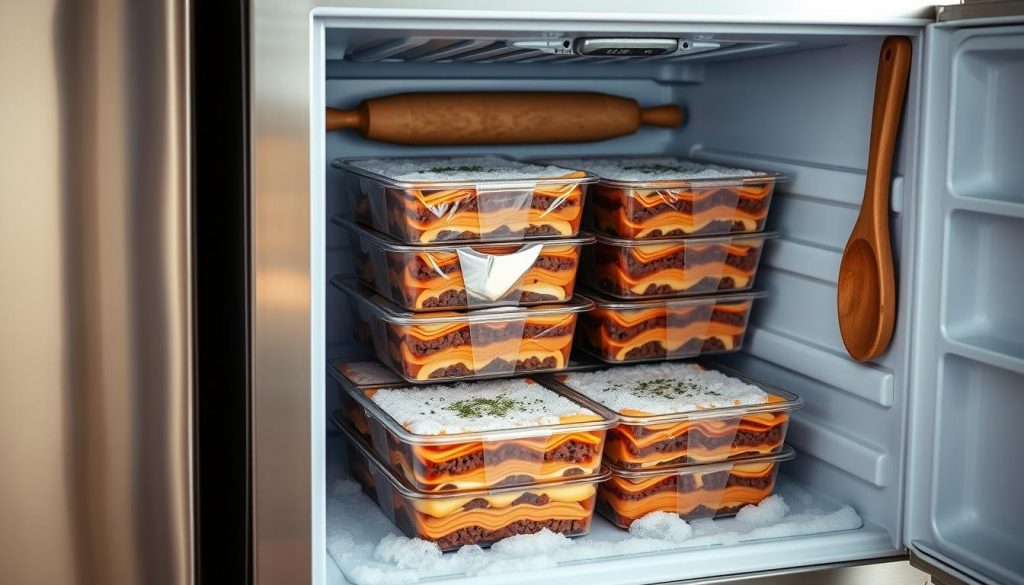Beef lasagna often leaves us with tasty leftovers. But how long can we safely keep it in the fridge? Let’s explore the best ways to store this beloved dish.
Our guide will help you extend your lasagna’s shelf life. We’ll ensure it stays safe to eat and maintains its delicious flavor.
Proper storage is crucial for keeping lasagna fresh and tasty. We’ll cover techniques to maintain its flavor and texture. You’ll learn how to store leftovers or meal prep like a pro.
Key Takeaways
- Proper storage extends lasagna shelf life
- Refrigerated lasagna lasts 3-5 days when stored correctly
- Use airtight containers for optimal freshness
- Monitor temperature to prevent bacterial growth
- Learn to spot signs of spoilage for food safety
- Freezing can extend lasagna’s lifespan significantly
Understanding Beef Lasagna Storage Basics
Proper storage keeps beef lasagna tasty and safe. Let’s explore how to store lasagna correctly for the best leftovers.
Proper Storage Temperature Requirements
Keep your fridge at 40°F (4°C) or below. This slows bacteria growth and keeps lasagna fresh. Use a thermometer to check your fridge often.
Ideal Container Types for Lasagna Storage
Choose airtight, shallow containers for lasagna storage. These cool food faster and spread temperature evenly. Glass or BPA-free plastic containers work great.
| Container Type | Pros | Cons |
|---|---|---|
| Glass | Doesn’t absorb odors, Microwave-safe | Heavy, Can break |
| Plastic (BPA-free) | Lightweight, Durable | May stain, Can retain odors |
| Silicone | Flexible, Freezer-safe | Can be pricey, May retain odors |
Role of Proper Wrapping Techniques
Wrap leftovers correctly to keep them fresh. Use plastic wrap or foil to cover lasagna tightly. This keeps air out and moisture in.
For extra protection, wrap the sealed container in foil. This helps maintain flavor and prevents fridge odors.
“Proper wrapping is like giving your lasagna a cozy blanket. It keeps the flavors in and the fridge odors out.”
Follow these storage tips to keep your lasagna delicious longer. You’ll enjoy tasty leftovers for days to come.
How Long Does Beef Lasagna Last in the Fridge
Food safety is key when storing lasagna. Knowing how long it lasts helps you enjoy leftovers safely. Let’s explore the best ways to keep your lasagna fresh.
Beef lasagna can stay good for 3-5 days in the fridge. This applies to homemade and store-bought types. Use airtight containers or wrap tightly with plastic or foil for best results.
| Storage Method | Duration |
|---|---|
| Refrigerator (40°F or below) | 3-5 days |
| Freezer (0°F or below) | 2-3 months |
These times assume you refrigerated your lasagna quickly after it cooled. Leaving it out for over two hours can speed up bacteria growth. This might make it unsafe to eat sooner.
“When in doubt, throw it out. It’s better to be safe than sorry when it comes to food safety.”
For the best taste, eat your refrigerated lasagna within 2-3 days. After this, it’s still safe but might not taste as good. Trust your senses and throw out any lasagna that seems off.
Signs of Spoilage in Stored Lasagna
Spotting food spoilage is vital for safety. Lasagna can show several signs of spoilage. Let’s look at the changes that indicate your lasagna has gone bad.
Visual Indicators of Spoiled Lasagna
Check for visible signs of spoilage first. Mold growth is a clear red flag. Look for fuzzy spots in green, white, or black colors.
Discoloration, like dark or yellowish patches, can also mean spoilage. These visual clues help you decide if the lasagna is safe.
Odor Changes to Watch For
Your nose can detect lasagna spoilage easily. Fresh lasagna should smell savory and pleasant. If you notice sour or rancid odors, discard the lasagna.
Trust your instincts. If the smell seems off, it’s safer not to eat it.
Texture Modifications That Signal Spoilage
Texture changes are another key sign of bad lasagna. Slimy pasta layers or gritty cheese texture indicate spoilage.
Excess moisture or ingredient separation can also mean the lasagna has gone bad. When unsure, it’s safer to throw it out.
- Look for mold or discoloration
- Check for off-putting odors
- Examine texture changes in pasta and cheese
- Watch for excessive moisture or ingredient separation
Stay alert for these spoilage signs to ensure you eat safe, tasty lasagna. With food safety, it’s always better to be cautious.
Best Practices for Refrigerating Homemade Lasagna
Storing homemade lasagna properly keeps it tasty and safe to eat. Here are some tips to help you save your yummy creation.

Cool your fresh lasagna to room temperature within two hours after cooking. This step stops bacteria from growing. It also keeps your dish tasting great.
Cut large portions into smaller ones for faster cooling. This also makes reheating easier later on.
Use airtight containers or wrap lasagna tightly with plastic wrap and foil. This double layer keeps your lasagna fresh longer. It also prevents freezer burn.
Remember, proper storage is key to enjoying your homemade lasagna for days to come!
Check out this handy guide for storing lasagna:
| Storage Method | Shelf Life | Best Practices |
|---|---|---|
| Refrigerator | 3-5 days | Store in airtight container, keep at 40°F or below |
| Freezer | 2-3 months | Wrap tightly, label with date, store at 0°F or below |
| Room Temperature | 2 hours maximum | Cover loosely, refrigerate promptly after cooling |
Follow these tips to keep your homemade lasagna fresh and tasty. Enjoy your delicious meal for days!
Extending Your Lasagna’s Shelf Life
Learn how to keep your lasagna fresh and tasty for longer. We’ll cover essential methods to preserve your beef lasagna. These techniques will help you extend its shelf life.
Proper Cooling Before Storage
Cooling lasagna correctly is crucial. Let it sit at room temperature for no more than two hours. Then, divide it into smaller portions to speed up cooling.
Place these portions in shallow containers and refrigerate immediately. This helps prevent bacterial growth and maintains food safety.
Airtight Packaging Methods
Use airtight containers or wrap lasagna tightly in plastic wrap or aluminum foil. This prevents air exposure and moisture loss. These factors are key in preserving lasagna quality.
Temperature Control Tips
Keep your refrigerator at 40°F (4°C) or below. Store lasagna in the coldest part of the fridge, usually the back. Avoid placing it near the door where temperatures change often.
| Storage Method | Shelf Life | Best Practices |
|---|---|---|
| Refrigeration | 3-5 days | Use airtight containers, cool quickly |
| Freezing | 2-3 months | Wrap tightly, label with date |
| Room Temperature | 2 hours max | Not recommended for storage |
These methods will help your lasagna last longer. Cool it quickly, use airtight packaging, and control the temperature. Your lasagna will stay safe and delicious for days to come.
Freezing vs. Refrigerating Beef Lasagna
Storing lasagna offers two main options: freezing or refrigerating. Both methods have unique benefits. Let’s explore each to help you choose the best option.
Freezer Storage Duration
Freezing lasagna is ideal for long-term storage. Properly wrapped and stored, frozen lasagna can last up to 3 months. This makes it great for meal prep or preserving large batches.

Thawing Methods and Safety
Thawing frozen lasagna requires careful handling. The best method is transferring it to the refrigerator overnight. This slow process preserves texture and flavor while preventing bacterial growth.
Quality Comparison Between Methods
Both methods preserve lasagna, but with different outcomes:
| Factor | Refrigeration | Freezing |
|---|---|---|
| Texture | Maintains original texture | Slight texture changes possible |
| Flavor | Preserves fresh flavors | Flavors may meld more |
| Convenience | Ready to reheat | Requires thawing |
| Storage Duration | 3-5 days | Up to 3 months |
Your timeline and preferences determine the best storage method. Refrigeration keeps the best quality for short-term storage. Freezing is ideal for longer periods, ensuring a ready-to-enjoy meal anytime.
Reheating Stored Lasagna Safely
Reheating lasagna can be tricky. We want to enjoy our leftovers without ruining taste or safety. Let’s look at the best ways to reheat this Italian classic.
The oven is ideal for reheating lasagna. It keeps the dish’s texture and flavor intact. Cover your lasagna with foil to lock in moisture.
Set your oven to 375°F and heat for about 25-30 minutes. This method helps prevent the lasagna from drying out.
For quick reheating, try the microwave. Put a slice on a microwave-safe plate. Add a splash of water or sauce.
Cover with a damp paper towel. Heat in 30-second bursts until hot throughout. This method is faster but may affect texture.
Safe food reheating is vital. Ensure your lasagna reaches 165°F inside. Use a food thermometer to check.
This guide on reheating lasagna offers more detailed tips. It’s a helpful resource for perfecting your technique.
| Reheating Method | Time | Temperature | Tips |
|---|---|---|---|
| Oven | 25-30 minutes | 375°F | Cover with foil |
| Microwave | 2-3 minutes | High | Add water, cover |
| Stovetop | 10-15 minutes | Medium-low | Use non-stick pan |
Proper storage is key for leftover lasagna. Cool it fully before refrigerating. Let it sit out for 15 minutes before reheating.
This helps it warm evenly. Following these steps ensures your reheated lasagna tastes great every time.
Food Safety Guidelines for Pasta Dishes
Pasta dish safety is crucial. The USDA recommends storing cooked pasta dishes in the refrigerator for up to five days. This ensures your meals stay fresh and safe to eat.
Preventing Cross-Contamination
Use separate cutting boards and utensils for raw meats and vegetables. This simple step can prevent cross-contamination and keep your leftovers safe. Wash your hands thoroughly before and after handling different ingredients.
Safe Handling Practices
Cool cooked pasta dishes quickly before refrigerating. Use shallow containers to speed up the cooling process. When reheating, ensure the internal temperature reaches 165°F (74°C) to kill potential bacteria.
By following these guidelines, you’ll enjoy your pasta creations safely. Remember, proper food safety is key to delicious and worry-free meals.




